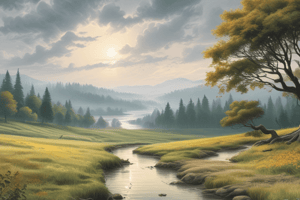Podcast
Questions and Answers
What is the purpose of utilizing symbols in poetry?
What is the purpose of utilizing symbols in poetry?
- To eliminate any need for interpretation by the reader
- To confuse readers and make the poem harder to understand
- To represent abstract or intangible concepts in a tangible way (correct)
- To provide a clear and straightforward meaning to the poem
In Robert Frost's 'The Road Not Taken,' what do the two roads symbolize?
In Robert Frost's 'The Road Not Taken,' what do the two roads symbolize?
- Choices in life (correct)
- The inevitability of fate
- Physical obstacles on a journey
- A preference for nature over civilization
Which literary device is commonly used in nature poetry to create an intimate connection with the natural world?
Which literary device is commonly used in nature poetry to create an intimate connection with the natural world?
- Irony
- Onomatopoeia
- Hyperbole
- Personification (correct)
What role does metaphor play in poetry?
What role does metaphor play in poetry?
How do literary devices like imagery and personification contribute to poetry's impact on readers?
How do literary devices like imagery and personification contribute to poetry's impact on readers?
Which analytical method is NOT commonly used to gain a deeper understanding of poetry?
Which analytical method is NOT commonly used to gain a deeper understanding of poetry?
In which region did Robert Frost typically find inspiration for his poetry?
In which region did Robert Frost typically find inspiration for his poetry?
What literary devices are exemplified in Frost's poems 'The Road Not Taken' and 'Stopping by Woods on a Snowy Evening'?
What literary devices are exemplified in Frost's poems 'The Road Not Taken' and 'Stopping by Woods on a Snowy Evening'?
Poets who focus on the natural world in their work are inspired primarily by the beauty, mystery, and ______ of nature.
Poets who focus on the natural world in their work are inspired primarily by the beauty, mystery, and ______ of nature.
Which of the following features is NOT typically associated with nature poetry?
Which of the following features is NOT typically associated with nature poetry?
Flashcards are hidden until you start studying
Study Notes
Exploring Poetry: Analysis, Robert Frost, Nature, Symbolism, and Literary Devices
Poetry, a timeless art form, encompasses a vast array of themes, styles, and techniques. In delving into the realm of poetry, we'll examine its analytical facets, the enduring work of Robert Frost, and the intricate relationship between poetry and nature, symbolism, and literary devices.
Poetry Analysis
Poetry analysis involves examining a poem's structure, language, and imagery to uncover its meaning and purpose. As with any literary work, poetry demands close reading and interpretation. Scholars and readers alike employ various analytical methods, including New Criticism, Reader-Response Theory, and Feminist Criticism, to gain a deeper understanding of specific poems or entire bodies of work.
Robert Frost
Robert Frost, an American poet born in 1874, remains one of the most celebrated poets of the 20th century. His poetry often reflects the landscape and culture of rural New England. Frost's works exhibit a masterful use of metaphor and symbolism, as evidenced in poems like "The Road Not Taken" and "Stopping by Woods on a Snowy Evening." These pieces exemplify Frost's ability to convey profound ideas through deceptively simple language.
Nature Poetry
Nature poetry, as the term suggests, focuses on the natural world and its elements. Poets often draw inspiration from the beauty, mystery, and changeability of the natural world, striving to imbue their work with a sense of wonder and awe. Poems in this genre frequently utilize metaphors and imagery to create a vivid, sensory experience for the reader. Examples of nature poetry can be found in the works of William Wordsworth, John Keats, and the aforementioned Robert Frost.
Symbolism
Symbolism is a literary device that employs an object, image, or concept to represent something more abstract or intangible. Symbols in poetry can be subtle, leaving readers to decipher their meaning, or overt, with the symbol's meaning clear from the outset. Frost's "The Road Not Taken" features a number of symbols, including the two roads themselves, which symbolize the choices in life. Other examples of symbolism in poetry include the rose in John Keats' "Ode to a Nightingale" and the apple tree in William Wordsworth's "The Tables Turned".
Literary Devices
Literary devices, such as imagery, metaphor, and personification, are essential tools in the poet's toolbox. Imagery, the representation of sensory experiences, is often employed to evoke emotion in the reader. Metaphor, a figure of speech that compares two unlike things, allows poets to create vivid, memorable images and make abstract concepts more accessible. Personification, the attribution of human qualities or behavior to non-human entities, is a common literary device in nature poetry, as poets often personify the natural world to create a more intimate connection between the reader and the landscape.
In summary, poetry encompasses a wide array of themes and techniques that invite readers to engage in intricate analyses and interpretations. Robert Frost exemplifies the masterful use of poetic form, symbolism, and literary devices, while nature poetry offers an introspective look at the natural world. By understanding these elements and applying them to a variety of poems, readers can deepen their appreciation of this art form and embark on a lifelong journey of poetic discovery.
Studying That Suits You
Use AI to generate personalized quizzes and flashcards to suit your learning preferences.




